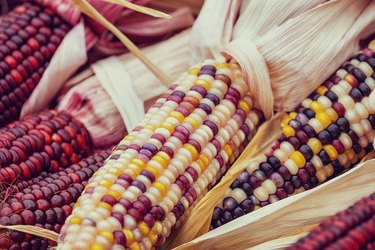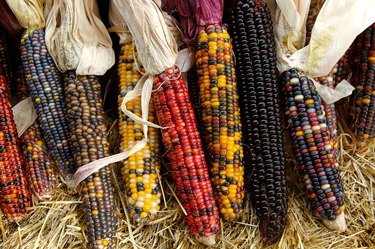Harvesting Indian corn and then using it in your fall decorations is an enjoyable pastime for the fall. But can you use the same pieces year after year, or do they always need to be replaced?
Cultivating and Saving Indian Corn

Luckily, you can preserve decorative Indian corn long after its season of harvest. That makes it great for use in wreaths for your front door or in a Thanksgiving table centerpiece. There are best practices for doing this so you can enjoy your seasonal autumn decor year after year.
Video of the Day
Video of the Day
For the most authentic experience, it's fun to harvest your own Indian corn when the season is right. First, Indian corn is distinctly different from white or sweet corn, which is most commonly consumed. It's also different from dent corn, also called grain corn, which is also white or yellow in color but typically grown for livestock since its taste isn't as sweet.
What Is Indian Corn?
Indian corn, also known as flint corn, contains dramatically less moisture than the other two types. It's called Indian corn because it is the breed grown by the native peoples of North America upon the arrival of Europeans. Because it has such little moisture, it doesn't spoil as quickly and can be preserved through long winter seasons to make dishes such as hominy and polenta.
It also has those naturally colorful kernels that are so prized for decorating, particularly during the fall. It's also relatively easy to grow in your backyard. In the spring, till your soil between 6 and 12 inches and provide plenty of compost or other nutrient-rich soil. You can plant in either rows or hills. The seeds will sprout and then grow through the spring and summer months.
Harvesting Indian Corn
You'll know when your Indian corn is ready to harvest simply by looking at it. The outer husks turn a shade of brown and begin to dry out, as well. Touch them to test them.
If you feel that they're ready, grasp the corn stalk in one hand and the ear in the other. Pull the ear away from the stalk in a downward motion. It should come out easily.
Repeat this process with the rest of your stalks, and you'll have a bushel of beautiful Indian corn.
Preserving Indian Corn

Indian corn is easy to preserve, which is, of course part of its value over centuries: It naturally lasts so that it can be eaten through the winters. Still, you'll need to completely dry it to prevent mold and mildew from growing on or between the kernels.
Tie several cobs together with twine near the bottom of their husks, then hang them somewhere warm and dry for several days or up to two weeks. To see if they're done, poke a kernel with your nail. It should leave no dent in the kernel.
Finally, apply a light layer of shellac to the corn. You'll probably need several layers to seal the kernels completely. This will deepen their natural color and help the kernels and cobs last for several years.